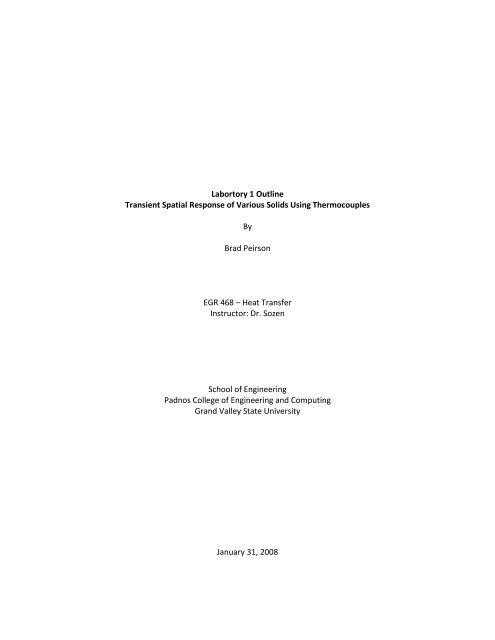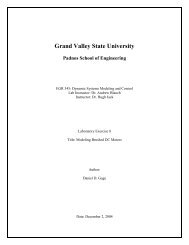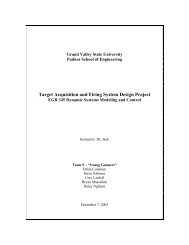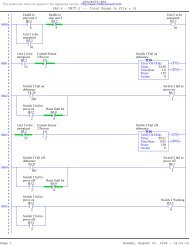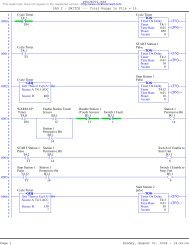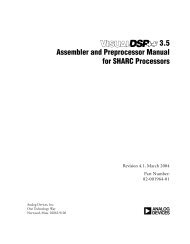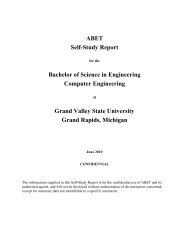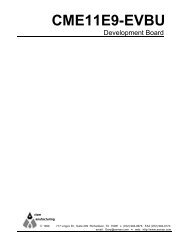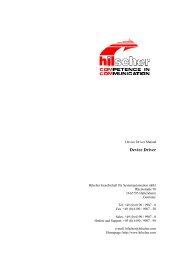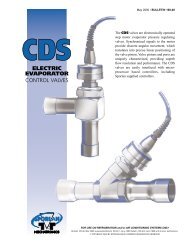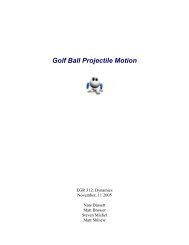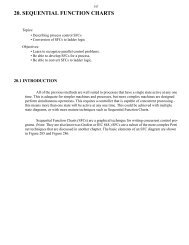Transient Spatial Response of Various Solids Using Thermocouples
Transient Spatial Response of Various Solids Using Thermocouples
Transient Spatial Response of Various Solids Using Thermocouples
Create successful ePaper yourself
Turn your PDF publications into a flip-book with our unique Google optimized e-Paper software.
Labortory 1 Outline<br />
<strong>Transient</strong> <strong>Spatial</strong> <strong>Response</strong> <strong>of</strong> <strong>Various</strong> <strong>Solids</strong> <strong>Using</strong> <strong>Thermocouples</strong><br />
By<br />
Brad Peirson<br />
EGR 468 – Heat Transfer<br />
Instructor: Dr. Sozen<br />
School <strong>of</strong> Engineering<br />
Padnos College <strong>of</strong> Engineering and Computing<br />
Grand Valley State University<br />
January 31, 2008
1.0 Introduction<br />
The general energy balance from thermodynamics applies to both blocks. Equation 1 shows the<br />
energy balance as applied in this experiment with no internal energy sources.<br />
2.0 Background<br />
The experimental setup consisted <strong>of</strong> two K type thermocouples inserted into solid blocks <strong>of</strong> two<br />
different materials. The first material tested was aluminum. The second was a potato cut into a<br />
similar sized block. Both blocks had two thermocouples inserted into them: one located in the block<br />
near the surface <strong>of</strong> the material and the other was located near the center <strong>of</strong> the material. The<br />
thermocouples were connected to a PC through a National Instruments CA 1000 connector<br />
assembly enclosure and a National Instruments Hi-Precision temperature and volt-meter. The<br />
blocks were placed into a bath <strong>of</strong> boiling water and the computer was used to chart the<br />
temperature at both locations in each block over time.<br />
3.0 Experimental Results<br />
Figure 1 shows the resulting Excel plot <strong>of</strong> the temperature <strong>of</strong> each block with time.<br />
Figure 1: Temperature versus Time for the Aluminum and Potato Block
4.0 Discussion<br />
Figure 1 shows that for both blocks the centerline temperature increased much less rapidly than the<br />
surface temperature. This is a direct result <strong>of</strong> more material between the center and the water than<br />
between the surface <strong>of</strong> the water. It would require significantly more heat (i.e. time) to heat the<br />
block through the center than it would to change the surface temperature.<br />
Figure 1 also shows that for both the center and the surface temperatures, the aluminum block’s<br />
temperature raised much more rapidly than the potato. This is a result <strong>of</strong> the composition <strong>of</strong> each<br />
material. The aluminum block has a thermal capacity <strong>of</strong> 0.896 kJ/kg°C [1]. The potato is mostly<br />
made <strong>of</strong> water, which has a thermal capacity <strong>of</strong> approximately 4.2 kJ/kg°C [1]. A higher thermal<br />
capacity implies that at a given surrounding temperature it will require more time to raise the<br />
internal temperature <strong>of</strong> the potato than the aluminum. This conclusion is supported in the<br />
experimental results.<br />
5.0 Conclusions<br />
The experiment was conducted in a bath <strong>of</strong> boiling water. This condition provides a certain measure<br />
<strong>of</strong> control that a similar experiment using ice water would not. At room temperature the blocks<br />
would naturally be above the temperature <strong>of</strong> the ice water bath. When lowered into the bath the<br />
temperature <strong>of</strong> the water closest to the blocks would be raised slightly as heat is transferred into<br />
the water. This would cause a natural convection at the surface with variations in the fluid<br />
temperature immediately surrounding the block.<br />
At room temperature the blocks are naturally cooler than the boiling water. However as long as the<br />
water is kept boiling it is in phase change, therefore the temperature will remain constant. This<br />
allows the system to be modeled with isothermal boundary conditions as opposed to convection<br />
boundary conditions.<br />
6.0 References<br />
1. Holman, J.P., Heat Transfer, Ninth Edition. McGraw Hill, New York, 2002.


